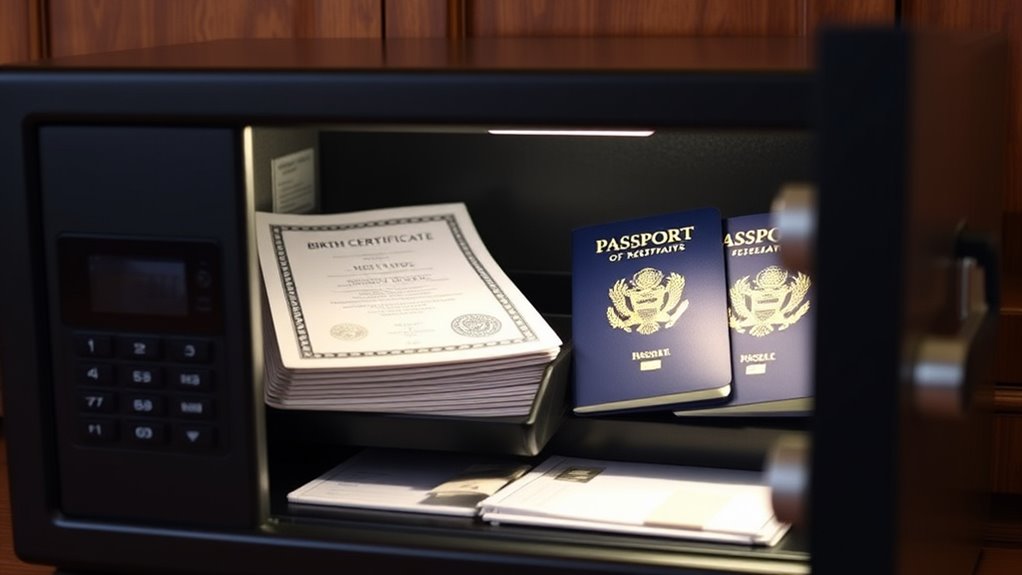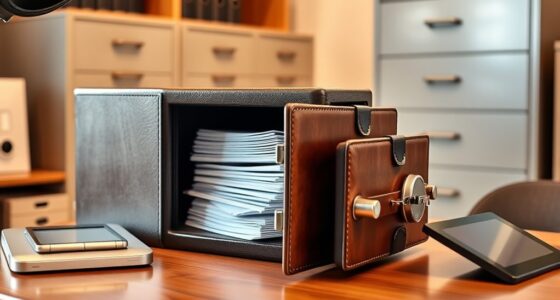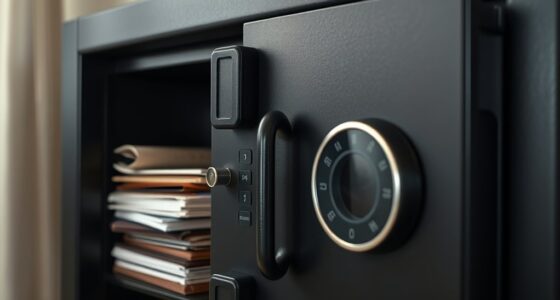To store birth certificates and passports securely, choose a fireproof and waterproof safe that’s properly sized for your needs. Keep backups in a secure, hidden location like a safety deposit box at your bank, and consider a lockable filing cabinet for everyday access. Create digital copies stored with encryption on trusted cloud services or external drives, and regularly review your storage setup. For more tips on protecting your essential documents, continue exploring your options.
Key Takeaways
- Store birth certificates and passports in a high-quality, fireproof and waterproof safe with secure locking mechanisms.
- Keep physical copies in a discreet, hidden location, such as a concealed safe or a locked drawer.
- Make digital copies and encrypt them on a secure cloud service or external drive with two-factor authentication.
- Use waterproof sleeves or pouches for documents to prevent water damage during emergencies.
- Regularly review access permissions and update storage arrangements to maintain security and organization.
Choose a Fireproof and Waterproof Safe

When selecting a safe for your important documents, it is crucial to choose one that is both fireproof and waterproof. Fireproof safes protect your birth certificates and passports from potential fire damage, ensuring they stay intact during emergencies. Waterproof safes are equally essential, guarding your documents against water from floods, leaks, or spills. Look for safes with high fire resistance ratings and water resistance certifications to guarantee durability. Consider the size and placement of the safe to make sure it fits your space and is easily accessible in emergencies. Investing in a quality fireproof and waterproof safe provides peace of mind, knowing your vital documents are protected from the most common threats. This combination ensures your important papers remain secure, dry, and safe over time. Additionally, incorporating secure storage practices can further enhance the protection of your critical documents in everyday life.
Use a Lockable Filing Cabinet or Drawer
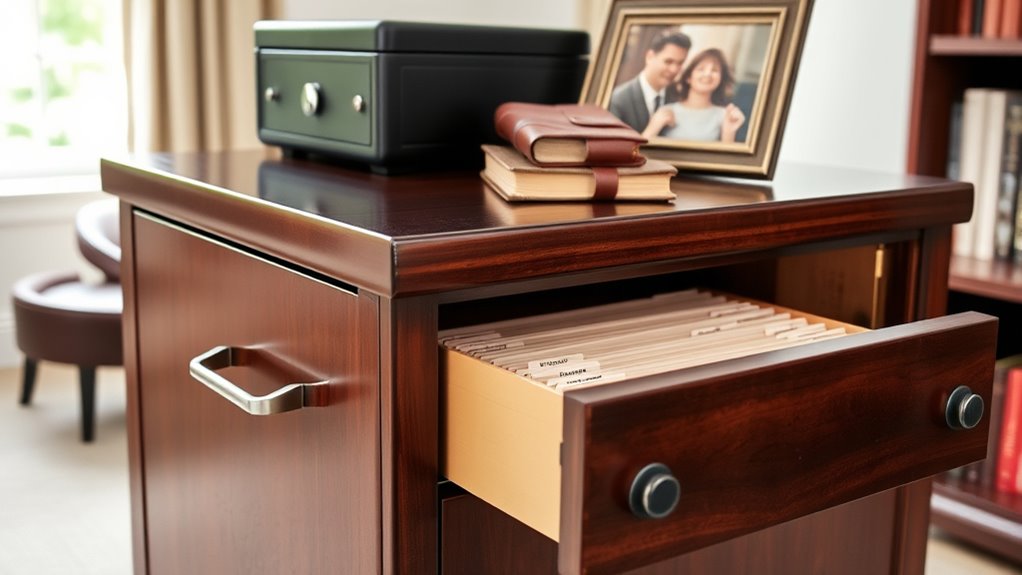
After choosing a fireproof and waterproof safe, the next step is to organize your documents in a secure and accessible way. Using a lockable filing cabinet or drawer helps prevent unauthorized access while keeping everything neat. Start by sorting your birth certificates and passports, then use clear label identification to mark each folder or section. This makes it easy to find what you need quickly without rummaging through clutter. Guarantee the cabinet is sturdy and lockable, and keep the key or combination secure. Regularly review your document organization to remove outdated items or update labels. Additionally, consider document security practices to ensure your sensitive information is protected from theft or damage. By maintaining a well-organized system, you protect your important documents and simplify retrieval during emergencies or travel.
Store Documents in a Secure, Hidden Location
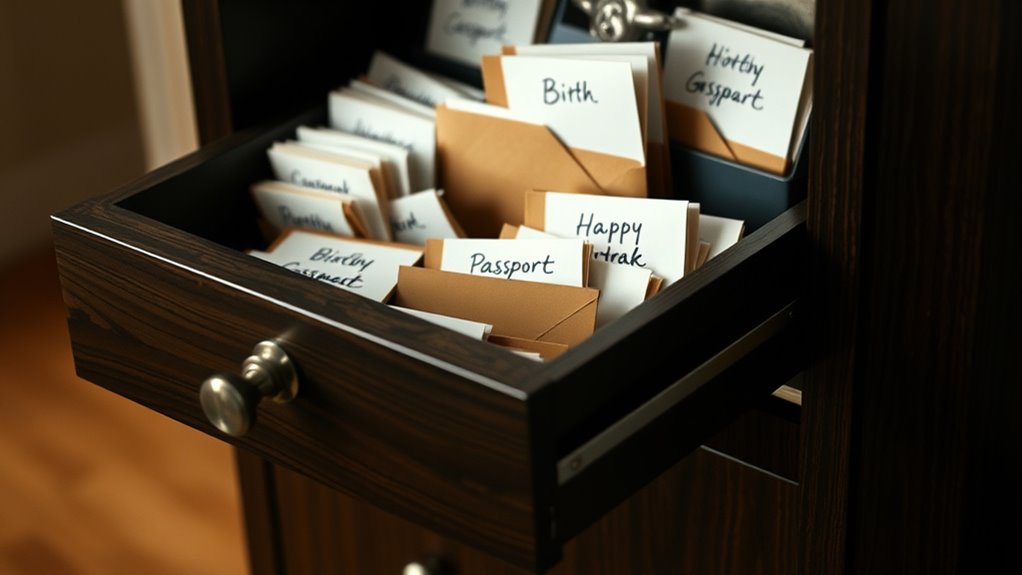
To protect your important documents, consider hiding them in a secure, discreet spot. Use concealed safe spots, such as hidden compartments or disguised containers, to keep them out of plain sight. You might also hide them behind walls or within other concealed areas for added security. Additionally, choosing high-quality storage methods can ensure your documents stay safe from damage and theft.
Concealed Safe Spots
Finding a concealed safe spot for your birth certificates and passports is essential for protecting them from theft, damage, or loss. Consider using hidden compartments or disguised storage within your home, such as hollowed-out books, false bottoms in drawers, or behind wall panels. These hidden compartments make it difficult for intruders to locate your important documents, adding an extra layer of security. Choose a spot that’s discreet but accessible when needed, ensuring it doesn’t draw attention. Avoid obvious places like safes or obvious drawers. By using disguised storage techniques, you keep your crucial documents out of sight from unwanted eyes. Remember, the goal is to create a safe, hidden refuge where your documents stay protected yet easy for you to access when necessary. Incorporating ethical leadership principles into your security practices can also ensure you consistently prioritize the safety and confidentiality of your important documents.
Discreet Storage Containers
Using disguised storage containers is an effective way to keep your birth certificates and passports secure and out of sight. These discreet storage options blend seamlessly into your home, making it less obvious that valuables are hidden inside. Look for containers that feature hidden compartments or false bottoms, which add an extra layer of security. You can repurpose common items like a hollowed-out book, a false-bottomed box, or a disguised jar to store important documents. The key is choosing discreet storage that doesn’t attract attention and is easy for you to access when needed. By using hidden compartments cleverly integrated into everyday objects, you reduce the risk of theft or accidental discovery, ensuring your essential documents stay protected and out of plain sight. Incorporating data management techniques can further enhance your security by keeping track of where your documents are stored.
Hidden Behind Walls
Hiding documents behind walls offers a highly secure way to keep your birth certificates and passports out of plain sight. By choosing concealed safe spots within your walls, you reduce the risk of theft or accidental discovery. You can install a hidden compartment behind a picture frame or inside a false wall panel. Make certain the concealment is discreet, blending seamlessly with your room’s design. Use sturdy materials to prevent easy access and consider adding a lock for extra security. Remember, the key is to make it appear like part of the wall, so it’s not obvious to anyone. This method keeps your important documents out of sight, protected behind walls that serve as an effective, hidden barrier. Necessary cookies ensure basic site functionalities are operational, supporting your overall privacy and security measures.
Consider a Safety Deposit Box at Your Bank
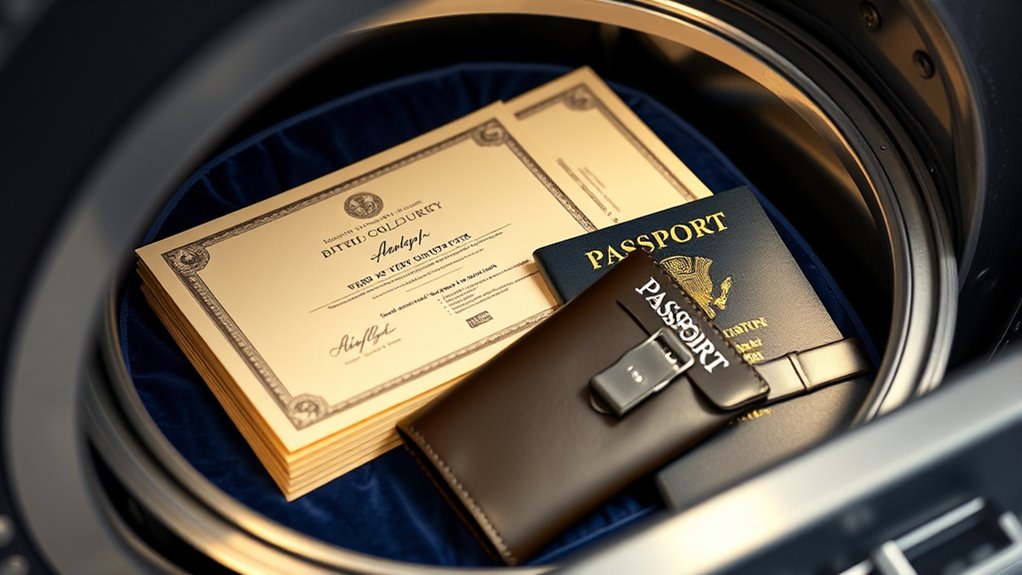
A safety deposit box at your bank offers a secure and reliable place to store your birth certificates and passports. With bank safety as a priority, these boxes provide strong protection against theft, fire, and other emergencies. Using a safety deposit box ensures your important documents are kept separate from your home, reducing the risk of loss or damage. Access is controlled and limited to you or trusted individuals, giving you peace of mind. While it may involve a small annual fee, the added security is worthwhile. This form of document storage keeps your vital records protected in a professional environment, avoiding potential hazards at home. Consider renting a safety deposit box for a safe, accessible storage solution for your most important documents. Sound design techniques can also be employed to ensure your documents are stored in a way that minimizes damage over time.
Make Digital Copies and Store Them Securely
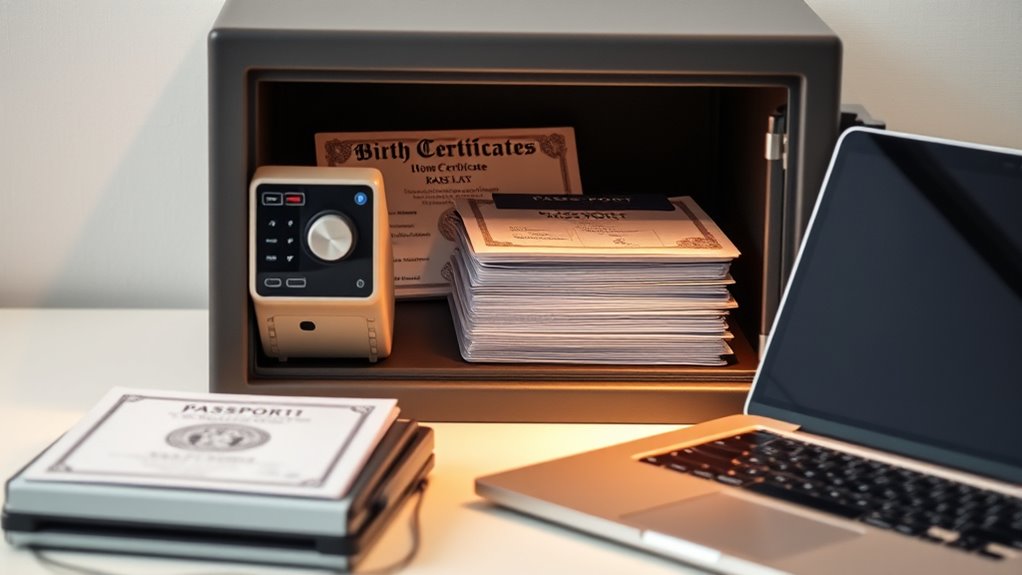
Creating digital copies of your birth certificates and passports is a smart way to protect your essential records. By making digital backups, you guarantee you have access even if the originals are lost or damaged. Store these copies securely using reputable cloud storage services with strong encryption and two-factor authentication. This way, your sensitive information stays protected from unauthorized access. Avoid keeping digital copies on unsecured devices or email accounts; instead, opt for encrypted external drives or secure cloud platforms. Regularly update your digital backups whenever your documents are renewed or changed. Remember, having secure digital copies provides peace of mind and quick access if you need to verify your identity, travel, or replace lost documents efficiently. Additionally, understanding document security best practices can further safeguard your important records.
Keep Original Documents in a Portable, Secure Container
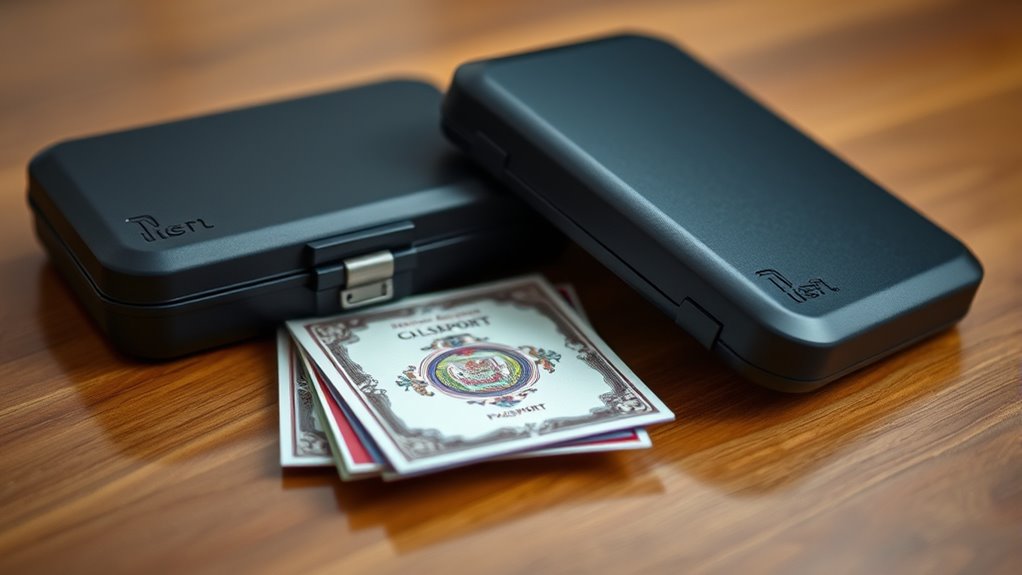
Choosing a sturdy, waterproof container guarantees your original documents stay safe and undamaged. You want it to be portable enough to carry when needed but secure enough to prevent unauthorized access. Finding the right balance helps protect your important papers effectively. Additionally, selecting a container with Necessary Cookies ensures essential security features are in place to safeguard your documents from external threats.
Choose a Durable Container
Selecting a durable container is essential to keep your birth certificates and passports safe and accessible. You want a container designed for paper storage that can withstand daily handling and environmental factors. Look for one made from sturdy materials like hard plastic or metal, which offer better container durability than flimsy options. This helps prevent damage from accidental drops, crushing, or bending. A high-quality container also provides a secure closure, preventing dust, dirt, and moisture from entering. Keep in mind, portability is key—choose a container that’s easy to carry without risking damage. Investing in a strong, reliable container helps preserve your important documents and keeps them ready whenever you need them. Additionally, document security features can provide extra protection against theft or loss.
Use Waterproof Materials
Since accidents happen unexpectedly, using waterproof materials is essential to protect your original documents from water damage. Waterproof materials provide reliable moisture protection, ensuring your birth certificates and passports stay dry in any situation. When selecting a container or sleeve, look for options made from durable, water-resistant materials like plastic, laminated fabric, or silicone. These materials prevent water from seeping in and damaging your documents.
Consider these points for optimal moisture protection:
- Use waterproof pouches or sleeves for individual documents
- Opt for containers with sealed, waterproof closures
- Store documents in a waterproof bag or case during travel
- Avoid materials that trap moisture inside
- Regularly inspect your waterproof storage for integrity
Choosing the right waterproof materials helps keep your important documents safe from water damage.
Keep It Accessible Yet Secure
After protecting your documents from water, the next step is guaranteeing you can access them quickly and securely when needed. Use a portable, secure container that allows for proper document organization, keeping each item easily identifiable. Implement access control by choosing a container with a lock or secure closure, limiting access to trusted individuals only. Keep your birth certificates and passports in a designated compartment or folder within the container to prevent clutter and damage. Regularly review who has access and update security measures if needed. This balance of accessibility and security ensures you can retrieve your important documents swiftly during emergencies while preventing unauthorized entry. Proper organization and access control are key to keeping your essential documents both safe and readily available.
Regularly Review and Update Your Storage Solutions

Regularly reviewing and updating your storage solutions guarantees your important documents remain secure and accessible. Over time, your document organization methods may become outdated, or access control measures might need tightening. Periodic checks help you identify any vulnerabilities or disorganized areas. Consider these key actions:
- Reassess the location of your storage to ensure safety
- Update access controls to limit who can retrieve sensitive documents
- Replace damaged or outdated storage containers
- Verify that your records are properly labeled and organized
- Keep a record of any changes made for future reference
Avoid Storing Sensitive Documents in Unsecured Places
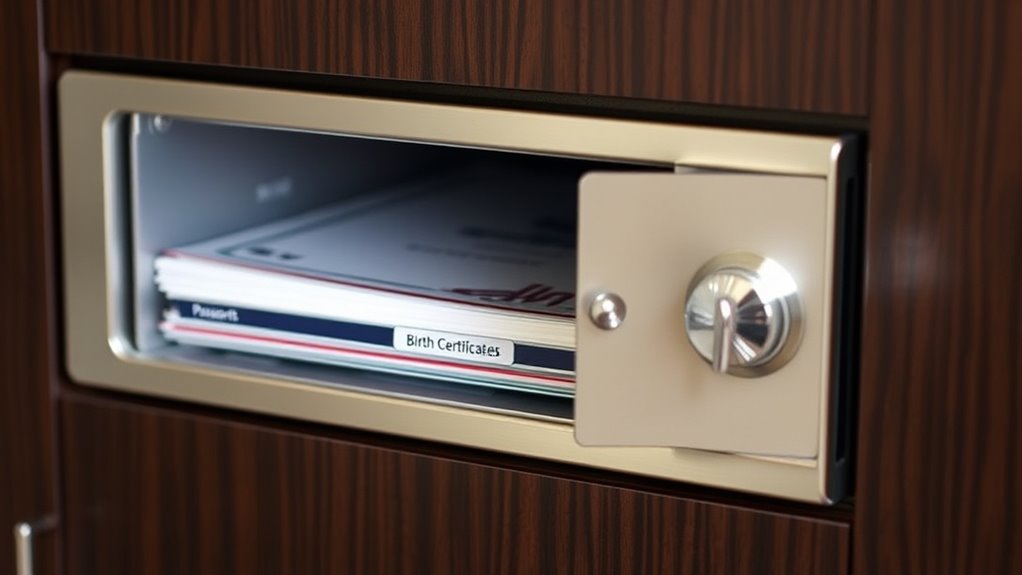
Storing sensitive documents in unsecured places considerably increases the risk of theft, loss, or damage. Avoid leaving your birth certificates and passports in obvious spots like drawers, handbags, or unlocked cabinets. Instead, consider creating digital backups stored securely online or on encrypted drives to guarantee access if the originals are misplaced or stolen. Keep physical copies in a locked, fireproof safe or a secure, hidden location. Also, review your insurance policies to understand coverage for lost or stolen documents, giving you added protection. Never leave sensitive documents in public areas or places vulnerable to theft, such as cars or shared spaces. Prioritizing secure storage helps safeguard your important documents against unforeseen events and makes sure they’re protected when you need them most.
Label Your Storage Items Clearly and Carefully
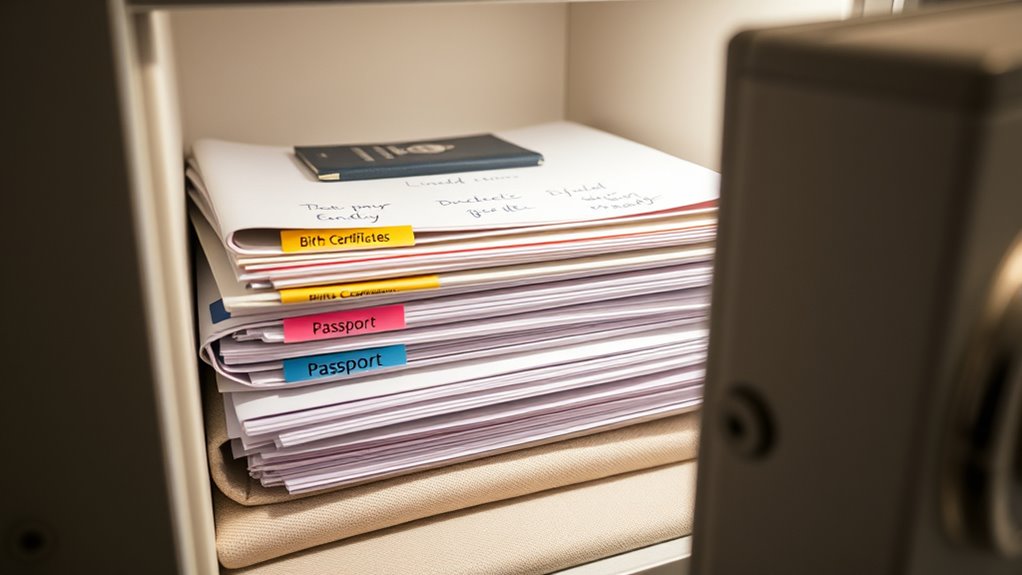
Label your storage items carefully and plainly to prevent confusion and guarantee easy access when needed. Proper label organization helps preserve your documents by reducing handling time and minimizing damage risks. Clear labels ensure you can quickly identify birth certificates, passports, and other essential records without rummaging through your safe or box. Use durable, legible tags or labels that won’t smudge or fade over time. Consider including:
- Document type (e.g., Birth Certificate)
- Date of storage
- Unique identifier (e.g., family member’s name)
- Fragile or important notes
- Storage location details
Share Access Only With Trusted Individuals
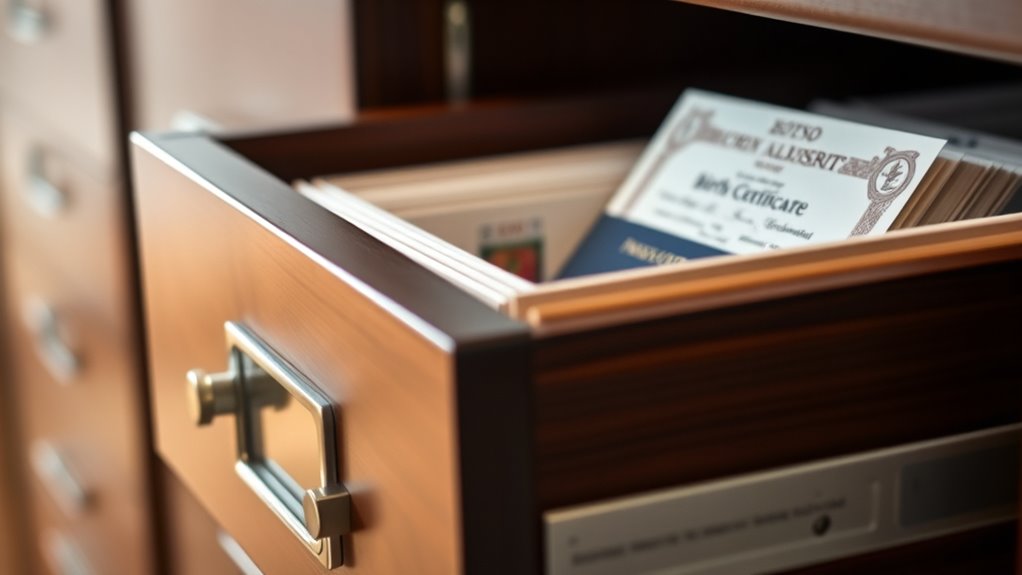
Once your documents are properly labeled and organized, controlling access becomes the next critical step. You should only share your birth certificates and passports with trusted contacts—people you know will handle them responsibly. Establish clear boundaries about when and how they can access these documents to maintain tight access control. Avoid giving copies or access to anyone you don’t fully trust, as mishandling or theft could occur. If someone needs temporary access, consider storing the documents securely elsewhere and only sharing them when absolutely necessary. Regularly review who has access, and revoke it if trust is broken or if they no longer need the documents. Remember, limiting access to trusted individuals helps keep your sensitive documents safe and minimizes the risk of theft or misuse.
Frequently Asked Questions
How Often Should I Review My Stored Documents for Security?
You should review your stored documents at least once a year to verify their authenticity and check for any signs of damage or tampering. Regular reviews help you confirm that emergency access remains straightforward and that no unauthorized changes have occurred. Staying vigilant ensures your essential documents stay secure, accessible, and in good condition, giving you peace of mind knowing your important records are protected and ready when needed.
What Are the Best Practices for Naming and Labeling Storage Containers?
You might worry that labeling standards could make your storage look cluttered, but clear labels actually improve container organization. Use consistent, descriptive labels with easy-to-read handwriting or printed text. Place labels on multiple sides of containers for quick identification from any angle. This helps you find documents fast, maintain order, and guarantees your storage remains secure and accessible. Proper labeling standards make your storage system more efficient and stress-free.
Can Digital Copies Replace Physical Originals for Legal Purposes?
Digital backups can’t fully substitute physical originals for legal recognition, so keep your originals safe. While digital copies are handy for quick access and emergencies, they may not be accepted as legal proof in all situations. Always store official physical documents securely, and use digital backups as supplementary references. Remember, having both ensures you’re prepared and compliant, providing peace of mind for any legal or personal needs.
How Do I Select a Reliable Safety Deposit Box Provider?
When choosing a safety deposit box provider, you should consider their reputation and safety deposit fees. Look for reviews and ask about their track record in safeguarding valuables. Confirm the fees are transparent and competitive. A reliable provider offers secure, well-maintained vaults, good customer service, and clear policies. Avoid providers with high fees or poor reviews, ensuring your sensitive documents like birth certificates and passports stay protected.
What Additional Security Measures Can I Take for Portable Storage Containers?
Think of your portable storage as a treasure chest—every layer of security adds to its strength. You can enhance protection by choosing fire-resistant containers that withstand flames like a fortress. Add tamper-proof locks to keep intruders at bay, ensuring no one can breach your defenses. Together, these measures create an unbreakable barrier, guarding your valuables with the resilience of a castle, so your important documents stay safe and sound.
Conclusion
By taking these secure storage steps, you protect your essential documents from theft, damage, and loss. Isn’t your peace of mind worth a little effort? Remember to regularly review your storage solutions and keep digital copies as backups. When it comes to your important documents, why leave them vulnerable? Stay proactive, stay safe, and guarantee your birth certificates and passports are always protected in the right secure place.
